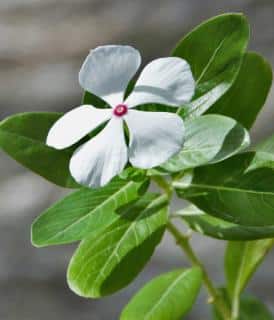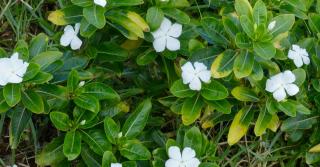

Madagascar periwinkle is a herbaceous plant native to the island of which it bears the name.
Madagascar periwinkle facts
Name – Catharanthus roseus
Family – Apocynceae or dogbane
Type – bush
Height – 10 to 20 in (0.25 to 0.5 m)
Exposure – full sun
Soil – well-drained
Foliage – evergreen (in warm climates)
Flowering – May to October-November
It will provide you with very cute blooming in summer. Formerly, the plant went by the names Alcea rosea and Vinca rosea. This is why the name “Vinca” pops up quite often.

But it’s also possible to grow Madagascar periwinkle as an annual from May to October without any problems at all.
To grow Madagascar periwinkle in a pot, it is advised to re-pot every 1 or 2 years, preferably in spring.
The pot provided upon purchase will quickly become too small: re-pot your Madagascar periwinkle as soon as its blooming is over.
Increasingly, Madagascar periwinkle is available as seeds.
It’s easy to sow the seeds:
If there are many slugs or snails, wait for the plants to have at least 4 pairs of leaves before thinning or transplanting.
If you’re growing your Madagascar periwinkle outdoors like an annual, simply pull the plant out once the first frost spells have hit. It wouldn’t survive the winter anyways.
If growing a Madagascar periwinkle indoors, in pots, you’ll have to prune it on a regular basis. Doing this helps increase blooming and controls its growth.
To boost flower-bearing, remove Madagascar periwinkle wilted flowers regularly (deadheading).
Madagascar periwinkle is typically grown as an annual plant in temperate climates. It isn’t a hardy flower.
Choose a very well-lit space for your Madagascar periwinkle, but not in direct sunlight behind a window.
Water regularly but not too much, to avoid suffocating roots.
Finally, bring your shrub outdoors from May to October to give it fresh air.
When in a pot, Madagascar periwinkle needs a lot of moisture. It loves resting over a tray of wet clay marbles or gravel. Indeed, this recreates its natural environment.
Madagascar periwinkle after flowering
The usual blooming season for Madagascar periwinkle extends from May to October.
Madagascar periwinkle leaves turn yellow most often when they were exposed to the cold or to lack of water.
If a cottony white substance starts covering the leaves of your Madagascar periwinkle, it means a scale insect colony has appeared.
Madagascar periwinkle can also be colonized by mites and ticks such as red spider mites.
In the wild, only two colors exist: white and pink. Today, through cultivation and breeding, many new colors exist: red, peach, apricot…
This is a very simple plant to care for. It is perfect to cover flower beds. Excellent for very sandy soil.
There is no need to remove dead flowers, they will simply fall off and quickly give rise to more!
This flower has been bred and cultivated for almost a hundred years. In the wild, only two colors can be found: purple-pink and white. In the 1920s, horticulturists started identifying promising Madagascar periwinkle varieties both tall and short.
Initially, breeders tried to expand the range of colors. Today, newer varieties are better at resisting disease, drought, cold and heat… thus generating savings for landscapers and hassle for owners!
Roots of this ornamental flower contain alkaloids. Research is ongoing that shows these compounds effective in treating cancer!

Also, this plant is similar to Impatiens (and to sunpatiens). To tell them apart, look at the center of the flower and the rim of leaves.
Adding organic flower plant fertilizer will enhance its bloom.
Hi I have a periwinkle (white) I tmis flowering since May. I live in an area in South Africa thats is very cold in winter, but my periwinkle still blooms
Thank you so much! This helped me with my flower essay project. I wanted to find resources so i could write about this amazing flower the rosy periwinkle and this helped so much!
You’re very welcome! It’s great that you took the time to thank me, too. It made my day!
Hi, what are the signs that the flower needs water and what are the signs that it has been overwatered? Also will it be okay if it rains like will it become overwatered?
Hi Katrina, though some of the symptoms are similar (like droopy leaves), it’ll be pretty clear if you check the following:
underwatering symptoms: dry soil at finger depth and leaves turn light green before switching to yellow and tips turn brown quickly as the leaf dries up.
overwatering symptoms: wet, moist soil at finger depth and leaves switch from darker green to yellow without turning pale green. Sometimes you’ll notice drops on the tips of leaves in this case.
A simple test is to take a before/after photo as you give it some water: if it’s underwatered, it’ll seem completely revived after a few hours. If it looks the same, then it’s overwatered… time to take steps to increase drainage!
Rainfall for outdoor periwinkle shouldn’t be a problem as such. It only becomes a problem if the soil doesn’t drain well. For instance, your flower bed might be at the bottom of a dip in the garden, or the soil is heavy clay that only lets water seep through very slowly. A great way to increase drainage is to “raise” your periwinkle up: create a raised garden bed and plant your flowers about 6 inches (15 cm) or more above the surrounding soil level, and it’ll be fine!
Thank you so much for the advice It’s my first plant I want to take care of it well.
sir, How to get a red color in this flower sir? Thanks
Hi Arvind, the only way to have red color in Madagascar Periwinkle is to purchase or find a variety that is red from the beginning. In this article about the different Madagascar Periwinkle varieties, you can look for those with “Red” in their name. Ask your local garden center if they have any for sale, or buy seeds of that variety online.